Shopping Cart is Empty
Paintball Hand Signals
Anybody that has played some kind of recreational paintball understands the need for silence on the field. Anybody that has played paintball understands the need for communication between team members. Hand signals provide that option, provided that each team member knows and understands them.
Most of us have played in some game where there is one guy that is just a little bit more into it then everybody else. He’s always trying to communicate with the team with hand signals. More than once have I looked to another member of the team and lamented, “It sure we be nice to know what he was saying”. Hopefully, this 50 card set will keep you from ever saying or thinking that again.
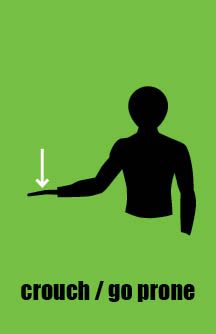
crouch / go prone
Crouch or crawl but do not stand up. Keep your head down and get to cover quickly.
Strategy | Use this when coverage is scarce or low or when under fire. It’s a good way to get between barriers or even to stay away from the barriers where the enemy may be expecting you. Crawling through grass is great as long as you are not seen. Ultimately though, if they know where you are, they’ll probably have a clear shot at you when you’re crawling through the grass.
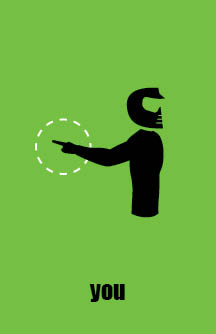
you
Simply use your index finger to point to the person you are talking to.
Strategy | A partial command, “you” would either preface or follow another command, such as “you, cover me”. As simple as it may seem, many commands are given without being specific as to who they are intended. If your teammate doesn’t know you are talking to them, your orders will be minimally carried out.
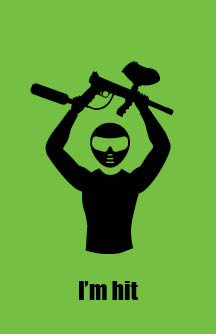
I’m hit
When you’re hit, put your marker high above your head in a horizontal position. Hold it there until you are off the field.
Strategy | If you see somebody doing this, don’t shoot them. They are out of the game. If performing this sign, make sure your paint stays in. Don’t underestimate this signal. If you don’t perform it properly, you may find that others don’t obey it properly. Paintballs hurt more when you are not actually in the game.
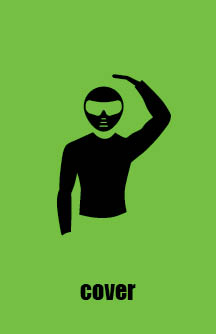
cover
Simply wave your hand over your head. Then designate the type of cover you need.
Strategy | The signal to “cover” will be followed by an indicated person or location. If the target is friendly, watch and protect that target by any means necessary. If the target is enemy, don’t allow them to act or move. This usually involves cover fire. Cover is usually used in advancement. One player covers another as he moves to a better location. Pinning down an enemy is another key use.
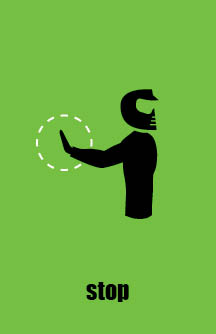
stop
Hold your hand up, fingers outstretched and together, palm towards the intended subject.
Strategy | It’s pretty simple - stop. If you were running onto the field, you are now to stop and should probably take cover. This is usually used when players are going at a faster pace, generally to warn them of a lurking danger ahead.
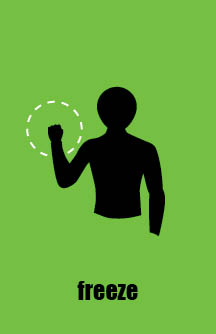
freeze
Hold your hand out to the side in a clenched fist. The back of your hand should face behind you.
Strategy | When told to “freeze”, players should hold their position without motion. The leader is watching and listening intently. Watch and listen with him. “Freeze” is generally used when players are slowly advancing as a team. They may or may not be moving. The command is generally used when more silence is needed. Another key use is to avoid detection by an enemy who may or may not have seen your position.
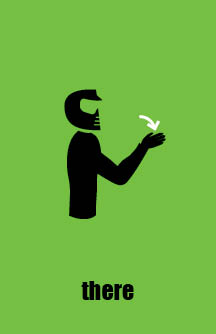
there
Use your whole hand, fingers outstretched, to point to a location, person, or other object.
Strategy | This is mostly used when directing people where to go or identifying where other people are. Basic pointing with the index finger is used to identify who you are talking to. Be sure not to confuse the two signals.
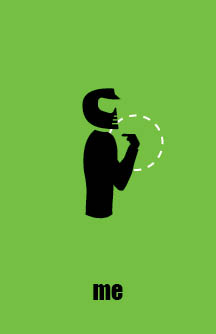
me
Simply point to yourself with your index finger.
Strategy | Use this when you want to identify yourself. You may want to use it when sharing a plan such as, “I’m going to move up on the left. You watch the right.”
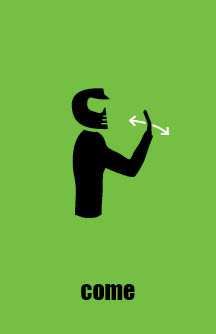
come
Bring your arm in front of you so your palm is toward your face.Then move your entire forearm towards and away from yourself repeatedly until understood.
Strategy | This command simply means to come to where you are. Use it when you need somebody to come to you, possibly to regroup, reload, or to make audible plans.
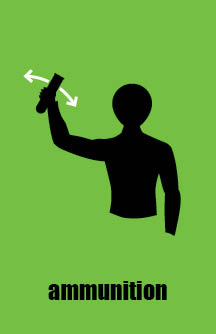
ammunition
Hold up the pod you just emptied and wave it from side to side.
Strategy | This one is very important to be used as a signal that is not visible to the other team. You do not want your opponent to know that you are out of ammo and completely vulnerable. However, if your team knows you need ammo, they may be able to bring you paint and allow you to remain in the game.
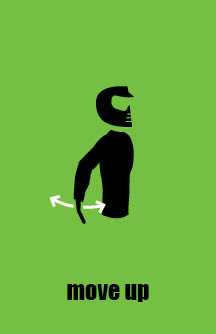
move up
Lower your arm slightly behind you and, using your forearm, wave forward.
Strategy | This is very important in a leap-frog type of situation. It’s your way to tell the teammates behind you that it’s safe to move up. Be ready to lay some cover fire for your comrades as you may be putting them in the line of fire.
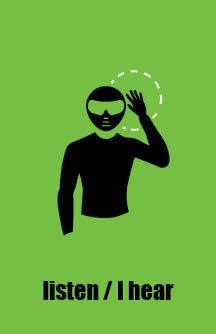
listen / I hear
Put your outstretched hand up to your ear as if listening for something.
Strategy | If you think that you hear something and your close teammates are making noise, give them this signal and they will know to stop and listen as well. If you want to tell them about something you hear, just designate what you hear after performing this signal.
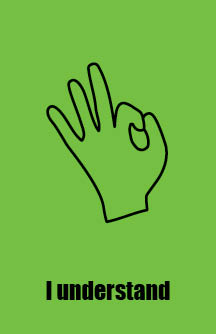
I understand
Present your hand and give the “okay” sign by putting your thumb and index finger together and raising the other fingers.
Strategy | This just clarifies to somebody that has just signalled to you that you understand what they have told you. It’s usually skipped but can add clarity to your teammate and let them know that you have understood them.
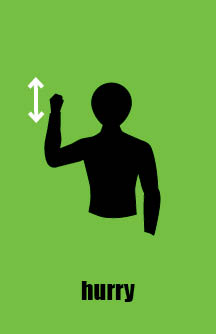
hurry
Raise your fist in the air out to the side. Then quickly raise and lower your hand repeatedly.
Strategy | Out of cautiousness, the rest of your team may not be getting in good position fast enough. Telling them to hurry may get you the help you need on the front lines. You may also have just cleared an area that your team will need to occupy quickly.
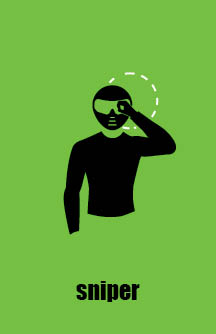
sniper
Hold your hand up to your mask as if you were looking through your fist.
Strategy | Snipers can be very dangerous. Their range allows them to tag you when you didn’t think anybody was nearby or even in range. Many a false sense of security has been shattered by a sniper’s shot to the unsuspecting. If you know about a sniper, make sure that you let your team know.
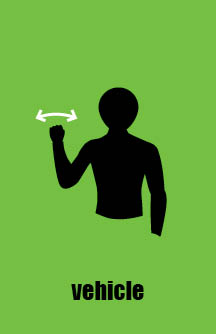
vehicle
Raise your fist to the side. Then wave your fist from side to side.
Strategy | This signal is for scenario play only. In a scenario, a vehicle such as a tank or convoy will often be connected to a main objective. If it’s a tank, it might just be very powerful and dangerous. Just let your team know when you see one.
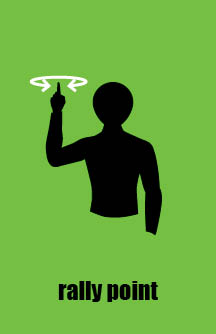
rally point
Raise your index finger in the air as if making a “number one” signal. Then wave your hand in a horizontal circle.
Strategy | You may need to regroup. Designating a rally point can quickly get everybody back together to exchange supplies or simply to make an audible plan.
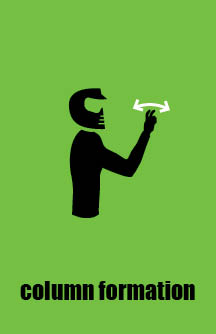
column formation
Holding up a bent index and middle finger, wave you hand forward and back repeatedly.
Strategy | You’re only going to need this if you’ve got a very large team, most likely in a scenario situation. A column formation simply means that the file is significantly longer than the width of ranks in the formation. In other words, people are spread more along the field then across.
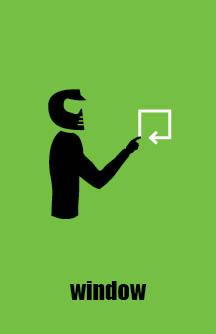
window
Use your index finger to draw a box in the air, mimicking the shape of a window.
Strategy | Use this for position identification. For example, there might be somebody in the window for which you might signal, “I see one in the window”.
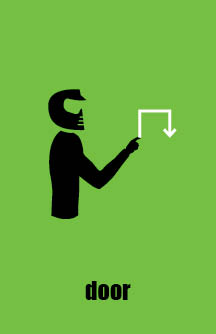
door
Use your index finger to draw a partial box in the air, leaving off the bottom, to mimic the shape of a window.
Strategy | Use this for position identification. For example, you may want somebody to make sure that whoever is inside of a structure remain inside. You might signal, “cover door”.
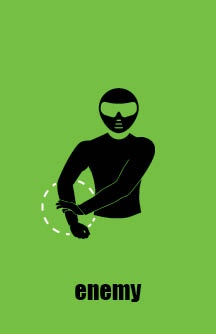
enemy
Use your thumb and index finger to grab the opposite wrist.
Strategy | This can come in very handy if you’re in one of those games that you can’t tell who’s who. Then, when you find out that somebody is, in fact, on the other team, you can let your teammates know your discovery. This will keep the paint flying at the right people.
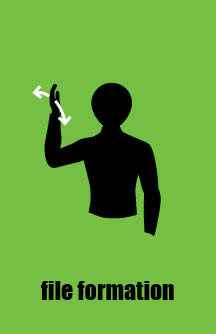
file formation
Raise your hand up to the side so that your palm runs parallel to your body. Then wave your hand forward and back repeatedly.
Strategy | You’re only going to need this if you’ve got a very large team, most likely in a scenario situation. A file formation simply means that the players are lined up single file, one behind another. Even in formation, be careful not to get to close to one another.
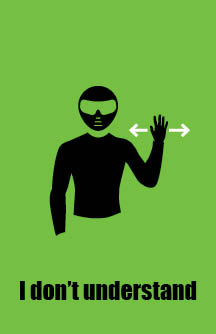
I don’t understand
Raise your hand to the front with your fingers extended and your palm forward. Wave your hand from side to side as if exchanging a greeting.
Strategy | More important than letting somebody know that you do understand is the signal to let them know that you don’t. If the signaller knows that you don’t understand, they can try again or try something else, but at least they won’t depend on you in a plan you don’t know.
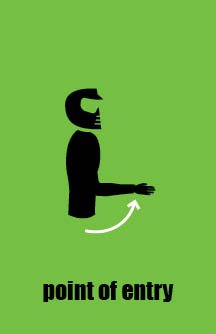
point of entry
Lower your arm to your side with your fingers outstretched and your palm facing toward your body. Then swing your forearm forward toward the entry.
Strategy | This is a useful signal in a scenario game where you may be trying to breach a structure of some kind. Finding a suitable entryway can sometimes be one of the most difficult parts. Again, when you know where it is, signal it to others.
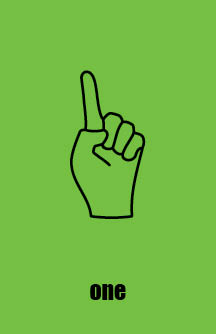
one
Present your hand, raising your index finger.
Strategy | Numbers might seem simple but they are very easily confused with other signals if not done carefully. Because you’re holding your marker in one hand, standard numbering isn’t possible. Paintball numbers are much the same as sign language numbers. Number signals are used along with other signals to represent the amount of something, such as, “One person, move up on the left side”.
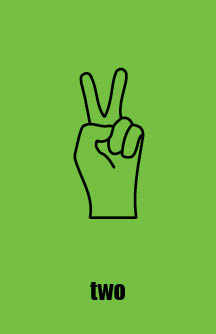
two
Present your hand, raising your index and middle finger.
Strategy | Numbers might seem simple but they are very easily confused with other signals if not done carefully. Because you’re holding your marker in one hand, standard numbering isn’t possible. Paintball numbers are much the same as sign language numbers. Number signals are used along with other signals to represent the amount of something, such as, “Two people, move up on the left side”.
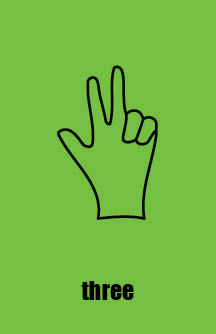
three
Present your hand, raising your thumb, index, and middle finger.
Strategy | Numbers might seem simple but they are very easily confused with other signals if not done carefully. Be careful not to confuse a 3 with a 6 or 9. Because you’re holding your marker in one hand, standard numbering isn’t possible. Paintball numbers are much the same as sign language numbers. Number signals are used along with other signals to represent the amount of something, such as, “Three people, move up the left side”.
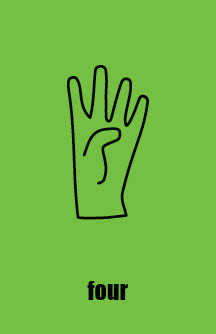
four
Present your hand, raising all of your fingers except your thumb.
Strategy | Numbers might seem simple but they are very easily confused with other signals if not done carefully. Because you’re holding your marker in one hand, standard numbering isn’t possible. Paintball numbers are much the same as sign language numbers. Number signals are used along with other signals to represent the amount of something, such as, “Four people, move up the left side”.
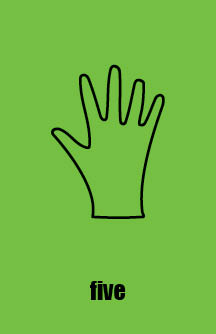
five
Present your hand, raising all your fingers. Do not to wave your hand.
Strategy | Numbers might seem simple but they are very easily confused with other signals if not done carefully. Because you’re holding your marker in one hand, standard numbering isn’t possible. Paintball numbers are much the same as sign language numbers. Number signals are used along with other signals to represent the amount of something, such as, “Five people, move up the left side”.
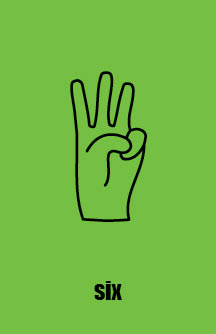
six
Present your hand, raising your index, middle, and ring finger.
Strategy | Numbers might seem simple but they are very easily confused with other signals if not done carefully. Be careful not to confuse a 6 with a 3 or 9. Because you’re holding your marker in one hand, standard numbering isn’t possible. Paintball numbers are much the same as sign language numbers. Number signals are used along with other signals to represent the amount of something, such as, “Six people, move up the left side”.
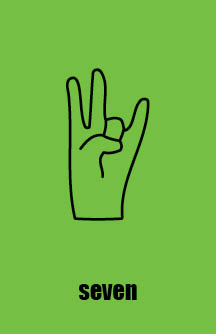
seven
Present your hand, raising your index, middle, and little finger.
Strategy | Numbers might seem simple but they are very easily confused with other signals if not done carefully. Because you’re holding your marker in one hand, standard numbering isn’t possible. Paintball numbers are much the same as sign language numbers. Number signals are used along with other signals to represent the amount of something, such as, “Seven people, move up the left side”.
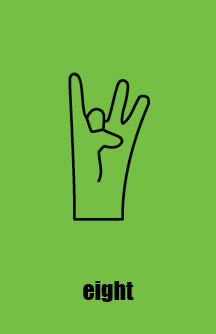
eight
Present your hand, raising your index, ring, and little finger.
Strategy | Numbers might seem simple but they are very easily confused with other signals if not done carefully. Because you’re holding your marker in one hand, standard numbering isn’t possible. Paintball numbers are much the same as sign language numbers. Number signals are used along with other signals to represent the amount of something, such as, “Eight people, move up the left side”.
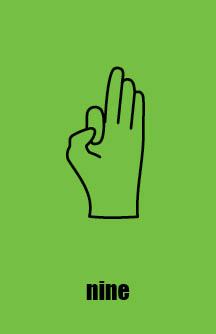
nine
Present your hand, raising your middle, ring, and little finger.
Strategy | Numbers might seem simple but they are very easily confused with other signals if not done carefully. Be careful not to confuse a 9 with a 3 or 6. Because you’re holding your marker in one hand, standard numbering isn’t possible. Paintball numbers are much the same as sign language numbers. Number signals are used along with other signals to represent the amount of something, such as, “Nine people, move up the left side”.
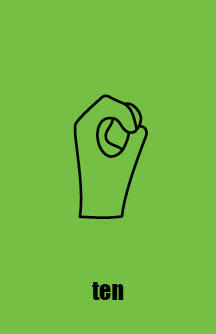
ten
Present your hand, pressing all fingers to your thumb in a hollow fist.
Strategy | Numbers might seem simple but they are very easily confused with other signals if not done carefully. Because you’re holding your marker in one hand, standard numbering isn’t possible. Paintball numbers are much the same as sign language numbers. Number signals are used along with other signals to represent the amount of something, such as, “Ten people, move up the left side”.
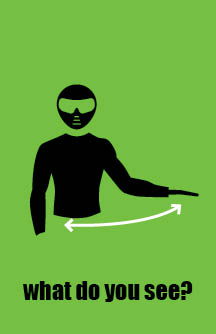
what do you see?
Fanning your fingers with your palm down, wave your arm in front of your body.
Strategy | Knowing where people are is the name of the game. If you don’t know where anybody is, you feel like a sitting duck. Sometimes you just feel antsy. Either way, asking this question can let you know what everybody else knows. That might make you feel better. It might not.
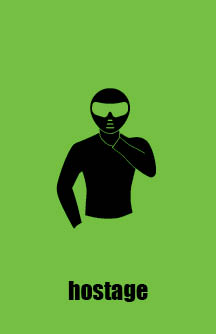
hostage
Place your fingers around your neck as if choking yourself.
Strategy | This is definitely a scenario signal. Freeing the hostages might be central to your objective or your enemy may have simply taken an extra hostage. Either way, pass along the information when you get it.
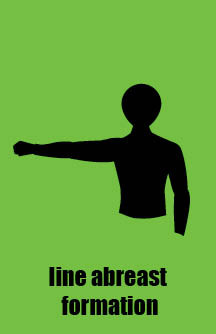
line abreast formation
Hold your arm directly out to the side with your hand in a fist.
Strategy | You’re only going to need this if you’ve got a very large team, most likely in a scenario situation. In a line abreast formation, also known as the rank formation, the players line up across the field. This can be useful if you need to keep anybody from getting behind you. Be careful not to get to close to one another.
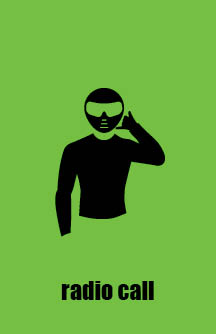
radio call
Put your hand up to your ear, with your thumb and little finger extended like a finger phone.
Strategy | Radios can be very useful in a game of paintball. Sadly, very few people actually have them. On a team where you are the odd one out without a radio, you may want to ask one of the other players to radio to another for you.
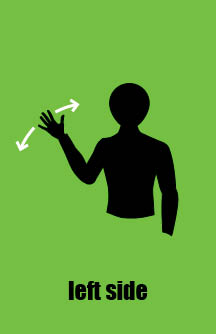
left side
Raise your hand to the left side with your fingers extended and your palm forward. Wave your hand from side to side as if exchanging a greeting.
Strategy | This can be used to direct your own team or to identify your opponents. You might signal something like, “I see two on the left side”.
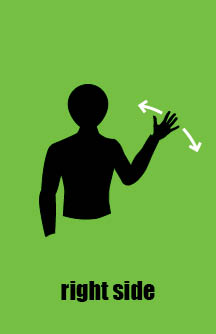
right side
Raise your hand to the right side with your fingers extended and your palm forward. Wave your hand from side to side as if exchanging a greeting.
Strategy | This can be used to direct your own team or to identify your opponents. You might signal something like, “cover the right side” or “two people move up the right side”
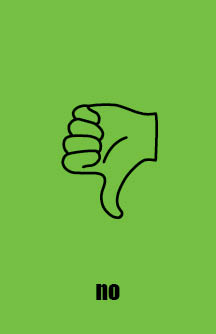
no
Present your hand with your fist clenched and thumb down.
Strategy | This is one of the simple signals that should be learned early on. As implied, it is used to respond negatively to a question.
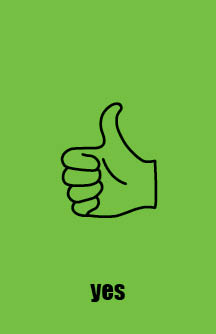
yes
Present your hand with your fist clenched and thumb up.
Strategy | This is one of the simple signals that should be learned early on. As implied, it is used to respond affirmatively to a question.
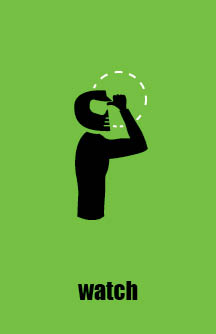
watch
With your hand in a fist and your thumb extended, touch the top of your goggles.
Strategy | This can be a useful signal if you are worried about somebody getting the jump on you. You can tell your teammate to watch that area. You’re not telling them to cover the area, simply to keep an eye on it. It could be as simple as signalling, “watch over there”.
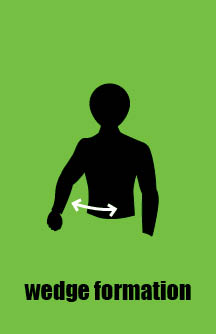
wedge formation
Lower your arm slightly behind you and wave your arm behind your back.
Strategy | You’re only going to need this if you’ve got a very large team, most likely in a scenario situation. In a wedge formation, or flying V, there is a point man and then players flanked off either side forming a V. A wedge is great for breaching the middle of the field. Even in formation, be sure to keep your players spread apart.
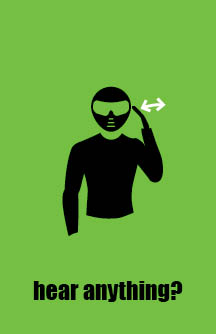
hear anything?
Tap your mask with your hand near your earpiece.
Strategy | Knowing where people are is the name of the game and sometimes your teammates may not be communicating what they know. Ask them what they know and you might have a better feel of the game.
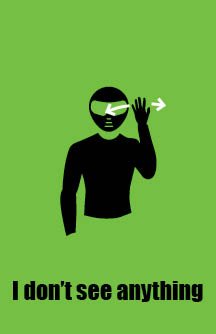
I don’t see anything
Raise your hand in front of your mask with your palm toward your face. Then wave your hand back and forth in front of your face.
Strategy | This may come as a response to a question or it may be a cry for help. Either way, if you don’t know anything, it’s important that your teammates know that. However, make sure you don’t yell this one across the field as it will expose your vulnerability.
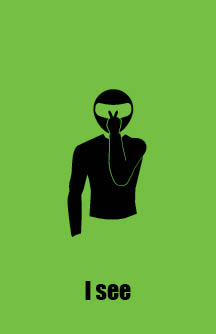
I see
Tap your goggles with your index and middle finger as if you were tapping your eyes.
Strategy | This is always a good signal to see. It means that somebody knows something. If you know where an opponent is, let somebody know. You might signal, “I see two people, over there.”
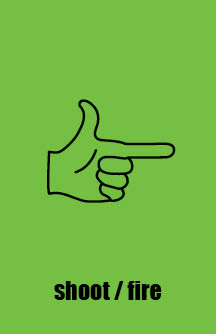
shoot / fire
Present your hand with your index finger pointed forward and your thumb extended, making a finger gun.
Strategy | This is commonly used along with the “cover” command to signal “cover fire”. It may also be used to tell somebody that you are going to fire upon something. You could also use it to tell somebody to shoot at something.
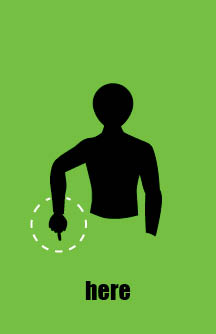
here
With your index finger, point at the ground below you.
Strategy | This command is generally accompanied with a command such as “move up”, “cover”, or “point”. It is much like the command “there” in that it simply points to a position, in this case, yours. If you had a good position but wanted to move up, you might signal to your teammate, “move up here”.
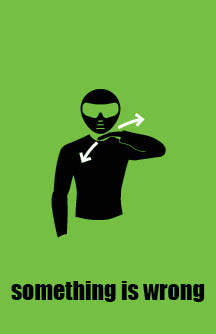
something is wrong
With your fingers outstretched and your palm down, make a slicing motion across your neck.
Strategy | There are far too many occasions where your equipment just isn’t working right. This can make you pretty vulnerable. If not properly communicated, it can also jeopardize your team. Simple signal, “something is wrong” and touch your marker to indicate that there is something wrong with your marker.
The Basics
Each card displays the hand signal on one side with the name of the command. On the other side, you will find an explanation of how to perform the signal as well as more in-depth information about when you might use the signal and how to make it most effective. They also offer examples of how signals might be used together to form full commands.
Signal Origins
One of the issues with hand signals is that many of them are not standard, merely signals that have been made up by one of those intense paintballers and have continued on by one means or another. Some of the signals on these cards would fall under that category. In another region of the country, some of these cards may not be compatible with signals of the area.
There are some standard signals that are used by members of the military, S.W.A.T., and other task forces that operate close range missions. These groups use standardized hand signals for close range engagement, also known as C.R.E. Many of the hand signals for paintball are the same as the C.R.E. hand signals and so many of the signals included in these cards are taken from the C.R.E. Each C.R.E. signal is indicated with a C.R.E. stamp in the bottom corner on the information side of the card.

.gif)
